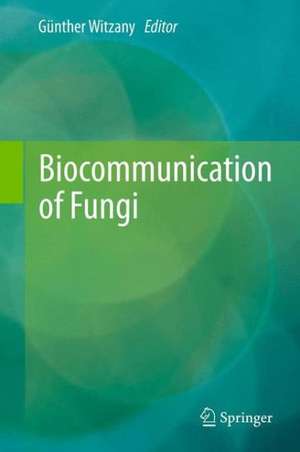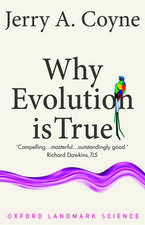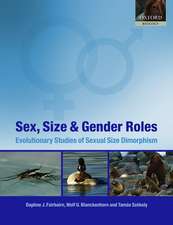Biocommunication of Fungi
Editat de Günther Witzanyen Limba Engleză Paperback – 12 iun 2014
| Toate formatele și edițiile | Preț | Express |
|---|---|---|
| Paperback (1) | 947.35 lei 6-8 săpt. | |
| SPRINGER NETHERLANDS – 12 iun 2014 | 947.35 lei 6-8 săpt. | |
| Hardback (1) | 952.09 lei 6-8 săpt. | |
| SPRINGER NETHERLANDS – 7 iun 2012 | 952.09 lei 6-8 săpt. |
Preț: 947.35 lei
Preț vechi: 1155.30 lei
-18% Nou
Puncte Express: 1421
Preț estimativ în valută:
181.28€ • 193.85$ • 151.14£
181.28€ • 193.85$ • 151.14£
Carte tipărită la comandă
Livrare economică 17 aprilie-01 mai
Preluare comenzi: 021 569.72.76
Specificații
ISBN-13: 9789400797475
ISBN-10: 9400797478
Pagini: 356
Ilustrații: XII, 344 p.
Dimensiuni: 155 x 235 x 19 mm
Greutate: 0.5 kg
Ediția:2012
Editura: SPRINGER NETHERLANDS
Colecția Springer
Locul publicării:Dordrecht, Netherlands
ISBN-10: 9400797478
Pagini: 356
Ilustrații: XII, 344 p.
Dimensiuni: 155 x 235 x 19 mm
Greutate: 0.5 kg
Ediția:2012
Editura: SPRINGER NETHERLANDS
Colecția Springer
Locul publicării:Dordrecht, Netherlands
Public țintă
ResearchCuprins
Preface.- Introduction: Keylevels of Biocommunication in Fungi.- 1. Intraorganismic Communication.- 1. G protein Signaling Components in Filamentous Fungal Genomes.- 2. The Glycogen Metabolism Regulation in Neurospora.- 3. Epigenetic Regulation of Secondary Metabolite Biosynthetic Genes in Fungi.- 4. Genes from Double-Stranded RNA Viruses in the Nuclear Genomes of Fungi.- 5. Signal Transduction Pathways Regulating Switching, Mating and Biofilm Formation in Candida albicans and Related Species.- 6. Cell-to-cell Communication in the Tip Growth of Mycelial Fungi.- 7. Programmed Cell Death and Heterokaryon Incompatibility in Filamentous Fungi.- 2. Interorganismic Communication.- 8. Communication and differentiation in the development of yeast colonies.- 9. Hyphal Interference: self versus non-self fungal recognition and hyphal death.- 10. Sexual Pheromones in the Fungi.- 11. Thoughts on Quorum Sensing and Fungal Dimorphism.- 3. Transorganismic Communication.- 12. Metabolite-Mediated Interactions between Bacteria and Fungi.- 13. Viruses, Fungi and Plants: Cross-kingdom Communication and Mutualism.- 14. Communication between plant, ectomycorrhizal fungi and helper bacteria.- 15. Lipid-mediated Signaling between Fungi and Plants.- 16. Fungus development and reactive oxygen. hytopathological aspects.- 17. Oxidative stress and oxylipins in plant-fungus interaction.- 18. Oxylipins in Fungal-Mammalian Interactions.- 19. Chemical Signals that Mediate Insect-Fungal Interactions.- Index.
Recenzii
From the book reviews:
“This book provides information about the various patterns of communications. … This book further serves as a learning tool for research aspects in biocommunication in fungi. It will guide scientists in further investigations on fungal behavior, how they mediate signaling processes between themselves and the environment. Should be available in all research laboratories dealing with mycology, community and university libraries.” (Anupama Daranagama and Kevin D. Hyde, Fungal Diversity, December, 2014)
“This book provides information about the various patterns of communications. … This book further serves as a learning tool for research aspects in biocommunication in fungi. It will guide scientists in further investigations on fungal behavior, how they mediate signaling processes between themselves and the environment. Should be available in all research laboratories dealing with mycology, community and university libraries.” (Anupama Daranagama and Kevin D. Hyde, Fungal Diversity, December, 2014)
Textul de pe ultima copertă
Fungi are sessile, highly sensitive organisms that actively compete for environmental resources both above and below the ground. They assess their surroundings, estimate how much energy they need for particular goals, and then realise the optimum variant. They take measures to control certain environmental resources. They perceive themselves and can distinguish between ‘self’ and ‘non-self’. They process and evaluate information and then modify their behaviour accordingly.
These highly diverse competences show us that this is possible owing to sign(aling)-
mediated communication processes within fungal cells (intraorganismic), between the same, related and different fungal species (interorganismic), and between fungi and non-fungal organisms (transorganismic). Intraorganismic communication involves sign-mediated interactions within cells (intracellular) and between cells (intercellular). This is crucial in coordinating growth and development, shape and dynamics. Such communication must function both on the local level and between widely separated mycelium parts. This allows fungi to coordinate appropriate response behaviors in a differentiated manner to their current developmental status and physiological influences.
This book will orientate further investigations on how fungal ecosphere inhabitants communicate with each other to coordinate their behavioral patterns and whats the role of viruses in this highly dynamic interactional networks. Additionally this book will serve as an appropriate tool to transport an integrated depiction of this fascinating kingdom.
These highly diverse competences show us that this is possible owing to sign(aling)-
mediated communication processes within fungal cells (intraorganismic), between the same, related and different fungal species (interorganismic), and between fungi and non-fungal organisms (transorganismic). Intraorganismic communication involves sign-mediated interactions within cells (intracellular) and between cells (intercellular). This is crucial in coordinating growth and development, shape and dynamics. Such communication must function both on the local level and between widely separated mycelium parts. This allows fungi to coordinate appropriate response behaviors in a differentiated manner to their current developmental status and physiological influences.
This book will orientate further investigations on how fungal ecosphere inhabitants communicate with each other to coordinate their behavioral patterns and whats the role of viruses in this highly dynamic interactional networks. Additionally this book will serve as an appropriate tool to transport an integrated depiction of this fascinating kingdom.
Caracteristici
First book on communicative competencies of fungal organisms Without communication no coordination of growth and development This book orientates further research on this topic














